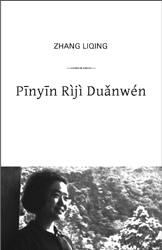 I’m very pleased to announce the publication of a new book, Pīnyīn Rìjì Duǎnwén, by Zhāng Lìqīng. Other than one introductory letter in English, the work is entirely in Mandarin.
I’m very pleased to announce the publication of a new book, Pīnyīn Rìjì Duǎnwén, by Zhāng Lìqīng. Other than one introductory letter in English, the work is entirely in Mandarin.
This is perhaps the world’s first Mandarin-language book to be published in Hanyu Pinyin without so much as one Chinese character. Thus, it is of historic importance. But it’s also a wonderful collection of stories. The author generously granted Pinyin.info the right to release all of this book online.
The work will also soon be available in an inexpensive printed edition.
Some of you will recall Zhang’s lovely story Dàshuǐ Guòhòu (“After the Flood”), which first appeared here three years ago. It leads the new collection. The remaining twelve memoirs/stories are mainly in the same vein, recalling a childhood in China and Taiwan.
Zhè shì yī gè lǎo gùshi. Shìqing fāshēng zài 1946 nián xiàtiān. Nà nián wǒ jiāngjìn shí suì, zhù zài Sìchuān Chéngdū jiāoqū d Bǎihuā Qiáo. Zhōngguó Kōngjūn Tōngxìn Xuéxiào d jīdì zài nàli. Wǒ bàba shì nà ge xuéxiào d jūnguān….
The author died earlier this year. She was able to view proofs of the work, though her illness prevented her from making any corrections herself. Fortunately, several people stepped in, contributing substantially to the checking of the Pinyin and other aspects of the work. I’d like especially to thank the following people: David W. Goodrich, Jiao Liwei, Kuo Hsin-chun, Melvin Lee, and Victor H. Mair. Any errors found in the book should be considered my own.
Please report any divergences from the Pinyin orthography established by Yin Binyong and the spellings used in the ABC Chinese-English Comprehensive Dictionary (Zhang was, after all, one of the associate editors of that massive work) to me. I’ve made very few intentional departures from those.
Please note that the use of “d” (where most authors would use “de”) is intentional. This is not a bug but a feature, something I came to understand better the more time I spent with this text. The use of “d” is explained in the second introductory letter (Liǎng Fēng Gěi Biānzhě d Xìn: 2).

Excellent. I will definitely pick up a hard copy too when it rolls off the presses.
“Please note that the use of “d” (where most authors would use “de”) is intentional. This is not a bug but a feature”
I still don’t like it, why not l and g too?
But still, this is tremendous news. and a worthy landmark. If I wanted to popularize pinyin I’d fund writing contests for children and teenagers for texts that have to submitted in pinyin only (with nice publications of the winners). But since through some horrible mistake of destiny I’m not filthy rich, I won’t be doing that myself.
Who will want to read that? O.O
I’m waiting for a traditional Chinese translation.
Greetings from Banciao.
Who will want to read that? O.O
Why, anyone who likes to read good stories in Mandarin, of course. ;-) But when it comes to a Hanzi edition, don’t hold your breath, my fellow Banqiao’er(?) (Banqiaor? Banqiaoite?, Banbrigian?), because this is going to stay in Pinyin. Sometimes the medium really is part of the message. Eventually, perhaps I’ll put out another edition with English annotations to help Mandarin learners.
@Michael: I don’t remember ever seeing l by itself; but g can be seen in Gwoyeu Romatzyh, where, for example, “y? gè” (or “y? ge”, to give another Pinyin variant form) is written “ig”. That, like the rest of GR, takes some getting used to — but, IMO, less getting used to than reading Hanyu Pinyin, even Pinyin with the d variant.
Speaking as an editor, dealing with a unified spelling for “de” is much easier. But as a reader, I not so sure. At any rate, this is what the author wanted. And since she was long involved in the romanization movement and was expert in Pinyin, who am I to say no.
It’s interesting you should mention a Pinyin writing contest. The foundations for just such a thing are presently being laid. It’s going to take some time to work out the particulars. And of course everything gets more complicated once money — not lots, but some — is involved. I’m hoping that this can be underway by the middle of next year.
Pingback: Book published in pinyin – don’t tell your kids « Mandarin Immersion Parents Council
I hate to say this, but: the entire book is in pinyin, then, with tonemarks… except for the very first thing on the very first page of the book, which is the author’s name, right there on the cover. Why on earth does she leave out the tonemarks there?
(And why does someone who I suppose thinks pinyin is a good idea spell their name ‘Kuo Hsin-chun’, for that matter? Taiwanese and romanization… it’s just not working.)
Pingback: You can pry hanzi from my cold, dead hands! | X in China
Adjectives, possessives, verbs, adverbs, use “de” but three different characters (????). Thus, she uses “de” for verbs and adverbs but uses “d” to adjectives and possessives, for classification.